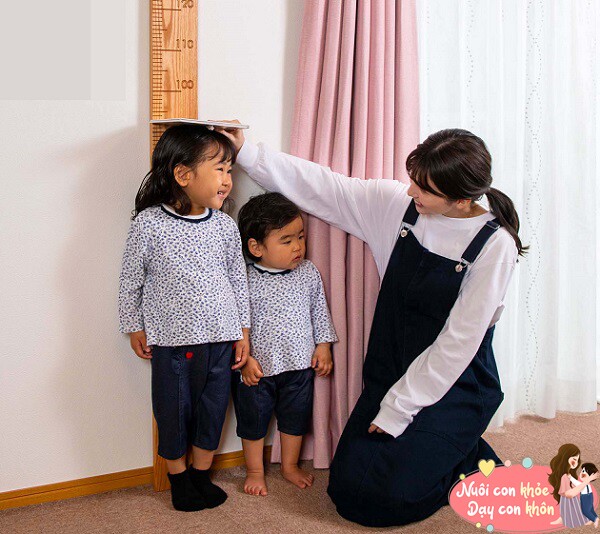It’s a common belief that “Girls take after their fathers, and boys take after their mothers”. However, this is only partially true as children inherit 50% of their genes from each parent.
Apart from facial features, children inherit various other traits from their parents, especially the following four, which are quite accurately passed on.

Children inherit many traits from their parents’ genes.

Body Shape
If both parents are tall and tend to gain weight easily regardless of their diet, their children are likely to inherit their body shape and predisposition to obesity.
Research has found that if only one parent is overweight, the child has a 30% chance of becoming obese. However, if both parents are obese, the child’s risk increases to 50-60%.
Nonetheless, the difference in basal metabolic rate between individuals with and without obesity genes is only 200-300 calories per day. As long as they lead an active lifestyle, exercise, and adjust their diet, their weight gain can generally be controlled.

Body shape is inherited through generations.
Being overweight not only affects health but also accelerates bone aging and shortens the growth period for height. If a child is already overweight, parents should find ways to help them control their weight, such as:
– Slowing down eating speed and increasing chewing times to allow the brain to signal fullness at the right time, thus reducing daily food intake.
– Adopting cooking methods that use less oil, such as steaming or making salads, while also minimizing the consumption of high-fat, high-salt, and high-calorie foods.
– Engaging in moderate daily exercise to burn excess fat.

Personality
In 1976, behavioral geneticists studied 850 pairs of twins and concluded that 30-60% of a child’s personality is influenced by inherited genes.
This study suggests that a child is not a blank slate but inherits innate temperament and personality traits while in the mother’s womb.
This can be explained from the perspective of brain science. Generally, if a person has low serotonin levels (responsible for controlling impulsivity, negative moods, and aggressive behavior), they are more likely to be irritable, anxious, and experience other mental instabilities.

Children inherit their parents’ temperament and personality traits.
If a parent’s temperament is like an active volcano that can erupt at any moment, it means their body releases relatively low levels of serotonin and high levels of stress hormones. This predisposition can be passed on to the next generation through their reproductive cells.
Although children are born with certain innate temperaments and personality traits, adequate care, emotional connection, soothing their restless souls, and nurturing their brain’s stress response system and hippocampus can help them develop a healthier personality.

Height
Research has found that 70% of a person’s height is determined by genetic factors, with each parent contributing 35% to this trait.
Most people believe that if neither parent has an ideal height, their child will likely not be tall either.
However, external factors account for 30% of height determination. If a child maintains a nutritious diet, exercises daily, and ensures sufficient sleep, they can surpass their predicted height.
Take the Dutch, the tallest people in the world, and the Belgians, the second tallest. Their sleep duration is also among the best globally. The average sleep duration for the Dutch is 7 hours and 28 minutes, ranking third in the world. Belgians, the second tallest people, also have one of the highest sleep durations.

70% of a person’s height is determined by genetic factors.
Additionally, the Dutch are known for their high consumption of dairy products. While their height is partly influenced by genetics, their diet also demonstrates the profound impact of external factors on height.
To estimate a child’s adult height, parents can refer to the Chinese height prediction formula.
For example: If the father’s height is 173 cm and the mother’s height is 161 cm, the average predicted height for their son is [(173+161)+12]/2=173 cm, ranging between 166.5 cm and 179.5 cm, which is within the normal range.
As the potential height range is quite large, if parents want their child to reach their desired height, they should focus on nutrition, sleep, and exercise. Additionally, maintaining a good relationship between parents and children is crucial to avoid unnecessary stress.

Facial Features
According to genetics, dominant traits are more likely to be passed on to offspring than recessive traits. Examples of dominant traits include double eyelids, long eyelashes, dark eyes, high nose bridge, pointed chin, full lips, and others. These traits tend to be more prominent.
Using lips as an example, if the mother has full lips and the father has thinner lips, the child is likely to inherit the mother’s full lips. This demonstrates that the combination of parental genes can result in unique traits in the child.
In other words, if one parent carries more dominant genes and the other carries mostly recessive genes, the offspring will tend to resemble the parent with dominant genes more closely.

Children inherit their parents’ facial features.
While a child’s personality, body shape, facial features, height, and other traits are significantly influenced by inherited genes, their environment also plays a crucial role.
Parents should create a conducive environment for their children’s development, encompassing nutrition, physical activity, rest, self-expression, and opportunities to shine.
A positive environment will encourage children to confidently express themselves, explore their interests, and develop the skills necessary for a successful life.
The Secret to Choosing the Perfect Wedding Dress: A Guide From an Expert Bridal Boutique Owner
Choosing the right wedding dress is about more than just accentuating your figure; it’s about showcasing the bride’s unique personality. Renowned wedding expert, Olivia Cheng, reveals the secrets to selecting a dress that flatters your face shape and body type. Are you ready to shine on your big day?
The Ultimate Guide to Power Dressing: Why Heels Beat Flats for the Ultimate Chic Office Look
As the leaves turn golden and the air becomes crisp, it’s time for a wardrobe refresh. This autumn, while pairing the perfect shoes with your maxi dresses, think beyond the beloved ballet flats. To elevate your look, both literally and aesthetically, opt for a different style of shoe. A pair of sleek heels or wedges will not only add height but also create a graceful and elegant silhouette.
The Top 3 Traits Sons Inherit From Their Mothers’ Genes.
When a child is born, people often wonder who they resemble more – their mother or father. The truth is, they inherit a mix of features from both parents. However, it’s not uncommon for a child to favor one parent over the other in certain aspects. Some children may bear a stronger resemblance to their mother, while others may lean more towards their father, and this can vary across different features and traits.






































